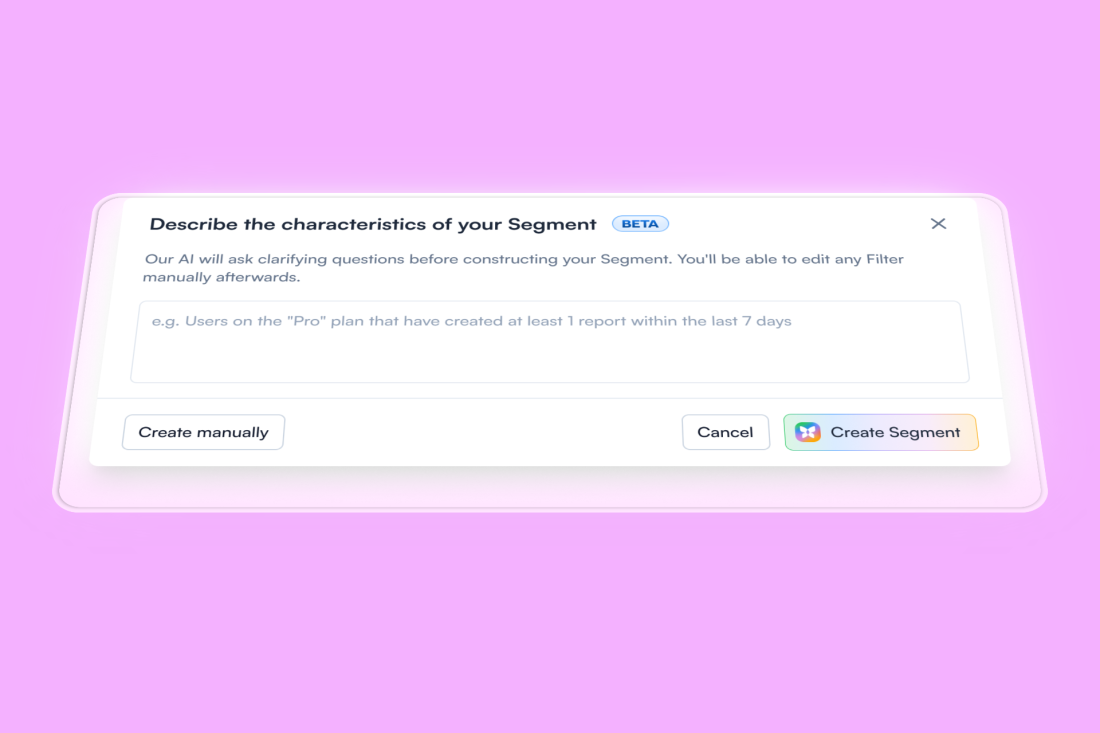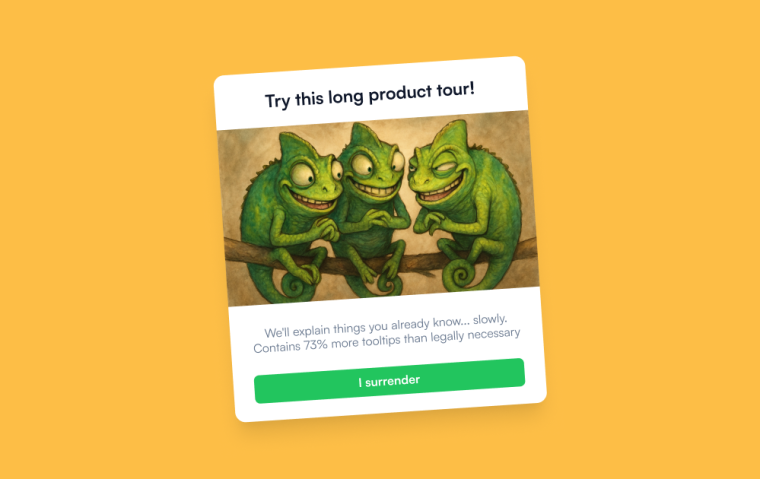Remember when onboarding meant the same five tooltips for everyone? Yeah, that's over.
AI isn't just another buzzword in the SaaS playbook. It's actually changing how products teach themselves to users. We're talking about onboarding that watches what you do, spots where you're about to get stuck, and shows up with help before you rage-quit. The companies doing this well? They're seeing real numbers: better activation, faster "aha!" moments, and fewer "how do I..." support tickets.
The problem is that "AI onboarding" has become marketing speak for everything from basic if-then logic to actual machine learning. So what does it really mean, and how do you build it without torching your roadmap?
This guide cuts through the noise. You'll learn the mechanics of adaptive onboarding, understand why it matters for B2B growth, and discover how to implement it effectively without hiring a data science team. Let's go...
The TL;DR of AI in user onboarding
-
AI onboarding adapts in real time to individual user behavior, delivering personalized guidance that drives measurably better activation rates and faster time-to-value than traditional static flows
-
The tech stack combines machine learning (pattern recognition and cohort analysis), NLP (conversational help), and predictive analytics (identifying at-risk users before they churn)
-
Real applications include dynamic content sequencing, automated A/B testing, just-in-time nudges, and proactive interventions that reduce support tickets while scaling without adding headcount
-
AI-first platforms like Chameleon let you describe your onboarding goal and auto-generate full campaigns with copy, targeting, and analytics built in, while others pepper AI features onto traditional tools
-
Start with data collection and user segmentation, then implement adaptive journeys using no-code platforms that let AI handle tactical execution while you focus on strategy.
What AI-Powered User Onboarding Actually Means
AI-powered user onboarding uses machine learning, natural language processing, and predictive analytics to automate, personalize, and optimize how new users discover value in your product. Unlike traditional onboarding, which follows static paths and manual configurations, AI-driven onboarding adapts in real-time based on user behavior, context, and needs.
The goal is simple: every user receives a personalized experience that accelerates activation and minimizes friction.
The Core Technologies Behind AI Onboarding
Machine Learning (ML) watches how users actually behave, spots patterns across thousands of sessions, and figures out which onboarding steps work for which people. No more guessing if your flow is effective. ML shows you what's actually driving activation.
Natural Language Processing (NLP) powers the chatbots and help widgets that let users ask questions like humans instead of searching through docs. They type "how do I export this?" and get an instant, relevant answer without ever leaving your product.
Predictive Analytics is your early warning system. It spots the signals that someone's about to bail (repeated errors, long periods of inactivity, skipped steps) and flags them before they ghost you. This lets you step in with help when it actually matters, not after they've already churned.
How AI Onboarding Differs from Traditional Approaches
Traditional onboarding treats users as segments. AI onboarding treats them as individuals.
Personalization at scale: AI builds a unique path for every single user, not just broad buckets. Power users get fast-tracked to advanced features. Cautious explorers get more hand-holding. Everyone gets what they actually need.
Continuous optimization: AI learns from every interaction and improves flows automatically. No more manually running A/B tests for weeks to figure out what works.
Proactive support: Instead of waiting for users to get stuck and ask for help, AI watches for friction signals and jumps in at exactly the right moment with exactly the right guidance.
Efficiency: AI handles the repetitive tactical work so your product team can focus on strategy. Less time building tours, more time thinking about what actually drives growth.
Why AI Onboarding Matters for SaaS Growth
AI onboarding isn't a nice-to-have. It's a growth lever that directly moves activation, retention, and revenue numbers.
Impact on Activation, Retention, and Revenue
According to Userpilot's 2024 benchmark report, the average B2B SaaS activation rate sits at 37.5%. Companies in AI and machine learning sectors are seeing activation rates as high as 54.8%, suggesting that intelligent, adaptive onboarding plays a significant role in getting users to value faster.
By delivering the right guidance at the right time, AI helps users reach their "aha!" moment faster, increasing the likelihood they'll stick around and become power users. This directly translates to improved retention and increased revenue growth.
Cost Efficiency: Reducing Support Load
Manual onboarding and reactive support are resource-intensive. AI onboarding automates repetitive tasks, instantly answers common questions, and guides users through complex workflows. This can significantly reduce support ticket volume, lowering costs while improving the user experience by providing immediate, in-context help.
Scalability Without Linear Resource Growth
As your user base grows, traditional onboarding methods require more human resources to maintain quality. AI onboarding scales effortlessly, handling thousands of new users with the same level of personalization and support, without ballooning headcount or costs.
Competitive Advantage in Crowded Markets
In a market where switching costs are low and alternatives are plentiful, delivering a seamless, personalized onboarding experience is a key differentiator. AI onboarding enables you to stand out, delight users from the start, and establish a reputation for innovation and customer-centricity.
7 Real Ways AI Transforms User Onboarding
1. Dynamic Personalization Based on User Behavior
AI analyzes user actions (clicks, navigation paths, feature usage) to determine which onboarding content is most relevant. Different user segments get different experiences based on their behavior patterns and characteristics.
Chameleon's AI Copilot creates targeted campaigns that align with user needs from the outset. Instead of one-size-fits-all tours, you can deliver segmented experiences where power users see advanced features while new users get foundational guidance. AI recommendations then help you optimize live experiences based on engagement data, enabling you to improve what works continually.
2. Intelligent Content Sequencing and Pacing
Not all users learn at the same pace. AI can sequence onboarding steps dynamically, slowing down for users who need more guidance and accelerating for those ready to explore advanced features. This ensures users never feel overwhelmed or bored, improving completion rates and satisfaction.
3. Predictive Intervention for At-Risk Users
By monitoring behavioral signals like inactivity, repeated errors, or skipped steps, AI can identify users at risk of dropping off. It then triggers proactive interventions, such as personalized nudges, reminders, or offers to connect with support. This reduces churn before it happens.
4. Automated A/B Testing and Optimization
AI can automatically create and test multiple onboarding variants, analyzing which messages, flows, or formats drive the best results. Chameleon's AI A/B variant creation lets teams spin up improved messaging tests in minutes, continuously optimizing onboarding without manual effort.
5. Natural Language Processing for User Queries
NLP-powered chatbots and help widgets enable users to ask questions in their own words and receive instant, context-aware answers. Chameleon's HelpBar AI Answers surfaces relevant documentation and guidance directly in-app, reducing friction and support dependency.
6. Smart Progress Tracking and Milestone Recognition
AI tracks user progress through onboarding, recognizing when key milestones are achieved and celebrating wins with timely feedback or rewards. This keeps users motivated and reinforces positive behaviors.
7. Contextual Help and Just-in-Time Guidance
AI determines the optimal moment to deliver tooltips, walkthroughs, or micro-surveys. Chameleon's Smart Delay feature uses AI-assisted timing to ensure guidance is both relevant and non-intrusive. This just-in-time approach increases engagement and reduces cognitive overload.
The Competitive Landscape: How AI Onboarding Tools Stack Up
Several platforms now offer AI-enhanced onboarding capabilities, but they vary significantly in approach and depth.
Userpilot has introduced AI localization features that translate and adapt onboarding flows, checklists, and surveys for different markets. Their platform focuses on no-code onboarding experiences with product analytics and feedback tools, making it accessible for teams without engineering resources.
Pendo recently launched AI-powered features in their Autumn 2025 release, including the ability to generate in-app onboarding flows from simple prompts. Pendo emphasizes eliminating onboarding steps entirely by using AI to identify and remove friction points.
Both platforms offer solid AI capabilities, but they approach the problem from a feature-addition perspective: adding AI to existing onboarding tools.
Chameleon takes a different approach. Rather than bolting AI onto traditional onboarding software, Chameleon is built as an AI-first product adoption platform. The difference shows up in how teams actually work.
With Chameleon's Copilot, you don't build onboarding experiences step by step. You describe your goal (like onboarding new users to a feature or announcing a product update), and Copilot handles the rest. It researches your product using web search to understand context, develops a strategic campaign plan tailored to your audience and objectives, then automatically builds multi-experience campaigns complete with copy, targeting rules, and goal configurations.
The result is production-ready in-app experiences that typically take hours to create, delivered in minutes, with strategic thinking baked in. Teams review, refine in the Builder if needed, and launch. This shifts the role from tactical execution to strategic orchestration, while Copilot handles the detailed work of campaign creation.
Beyond Copilot, Chameleon offers AI throughout the platform:
AI copy in the Builder generates or improves copy for tours, tooltips, embeddables, microsurveys, and launchers
AI recommendations provide tips on live experiences to boost engagement, tailored to your content
AI A/B variant creation spins up improved variants for messaging tests
Microsurvey AI summaries automatically roll up open-text feedback
HelpBar AI Answers surface answers from your docs via Command+K search
Smart timing uses AI-assisted Smart Delay to trigger experiences at better moments
AI-powered interactive demo creation using voice narration
This comprehensive, AI-native approach positions Chameleon as the next generation of user onboarding platforms: not just adding AI features, but reimagining how product teams create and manage adoption campaigns from the ground up.
Book a demo to discover AI-first user onboarding
So you can get back to orchestrating product adoption
The Chameleon Framework: Building Your AI-Powered Onboarding Flow
Implementing AI onboarding doesn't require a complete rebuild. Here's a practical framework for getting started.
Phase 1: Data Collection and User Segmentation
Start by gathering behavioral, demographic, and contextual data from your users. Use this data to segment users based on needs, goals, and product usage patterns. Chameleon's no-code platform makes it easy to define segments and trigger personalized onboarding flows without engineering dependencies.
Phase 2: AI Model Selection and Integration
Choose the right AI models for your onboarding goals. Whether it's ML for user segmentation, NLP for in-app support, or predictive analytics for churn prevention, integrate these models with your onboarding platform via APIs or built-in connectors.
Phase 3: Creating Adaptive User Journeys
Design onboarding journeys that adapt in real time to user actions. With Chameleon's Copilot, you simply describe your onboarding goal, and Copilot researches your product, develops a strategic campaign plan, and automatically builds multi-experience campaigns complete with copy, targeting, and goal configurations.
This approach removes the bottleneck of manual campaign creation and lets AI handle the tactical details while you focus on strategic outcomes.
Phase 4: Implementation with No-Code Tools
Leverage no-code tools like Chameleon to build, test, and launch onboarding experiences without engineering bottlenecks. Copilot shifts your team's role from tactical execution to strategic orchestration, letting AI handle the details while you focus on high-level goals.
Phase 5: Testing, Measuring, and Iterating
Continuously monitor onboarding performance using built-in analytics. Test different flows, messages, and interventions, and let AI recommend optimizations. Chameleon's AI recommendations and analytics help you identify what's working and where to improve.
Measuring AI Onboarding Success: KPIs That Matter
Primary Metrics: Activation Rate, Time-to-Value, Feature Adoption
Track the percentage of new users who complete onboarding and reach key activation milestones. Measure how quickly users achieve their first value moment (time-to-value) and monitor adoption rates for core features.
These metrics tell you whether your onboarding is actually moving users toward value or just checking boxes.
Advanced Analytics: Predictive Churn Scoring and Engagement Quality
Use AI to score users based on their likelihood to churn, and analyze engagement quality, not just quantity. Chameleon's analytics capabilities provide deep insights into user behavior, helping you prioritize interventions and resources where they'll have the most impact.
ROI Calculation Framework for AI Investments
To justify AI onboarding investments, calculate ROI by comparing pre- and post-implementation metrics:
Reduction in support tickets
Increase in activation and retention rates
Decrease in time-to-value
Cost savings from automation
Visualize these gains with before/after charts to communicate impact to stakeholders and build the case for continued investment.
The Future of AI in User Onboarding
Emerging Trends: Voice AI and Emotional Intelligence
Voice-powered onboarding and AI that detects user sentiment are on the horizon, promising even more intuitive and empathetic user experiences. Expect onboarding to become increasingly conversational and emotionally intelligent, adapting not just to what users do, but how they feel.
Chameleon's AI-powered interactive demo creation using voice narration is an early example of this trend, making it easier to create engaging, human-feeling onboarding experiences at scale.
Ethical Considerations and Privacy Compliance
As AI collects and analyzes user data, privacy and ethics must remain top priorities. Ensure compliance with regulations like GDPR and be transparent about data usage. Build trust by giving users control over their data and explaining how AI enhances their experience.
The best AI onboarding systems are transparent, respectful, and designed with user consent at the core.
Preparing for What's Next
Stay agile by continuously monitoring AI trends and updating your onboarding strategy. Invest in platforms like Chameleon that evolve with the technology and keep you ahead of the curve. The companies that win in the next decade will be those that treat AI not as a feature, but as a fundamental part of how they deliver value to users.
The Bottom Line
AI in user onboarding isn't just a trend. It's becoming the standard for SaaS growth. By leveraging machine learning, NLP, and predictive analytics, you can deliver personalized, adaptive, and scalable onboarding experiences. The result: higher activation rates, faster time-to-value, and a clear competitive edge.
The difference between adding AI features and building AI-first is significant. Platforms like Userpilot and Pendo offer valuable AI capabilities, but Chameleon reimagines the entire workflow. With Copilot and AI throughout the platform, teams move from tactical execution to strategic orchestration, creating better experiences in less time.
The question isn't whether to adopt AI onboarding. It's how quickly you can implement it and start seeing results. With frameworks like the one outlined here and tools like Chameleon's Copilot, implementing AI onboarding is more accessible than ever.
Ready to see AI onboarding in action? Book a Chameleon demo to explore how AI-first product adoption can transform your user experience.
-
AI in user onboarding enables real-time personalization, proactive support, and continuous optimization. This leads to higher activation rates, faster time-to-value, reduced support tickets, and scalable onboarding processes that adapt to each user’s needs, giving SaaS companies a measurable competitive advantage.
-
AI-driven onboarding analyzes user behavior to deliver tailored guidance and interventions at the right moments. By adapting onboarding flows in real time and predicting friction points, AI helps more users reach key milestones, resulting in significantly higher activation rates than static, one-size-fits-all approaches.
-
ROI can be measured by comparing pre- and post-implementation metrics such as activation rates, time-to-value, feature adoption, and support ticket volume. Calculating cost savings from automation and increased revenue from improved retention provides a clear picture of the business impact of AI onboarding.
-
Common challenges include data silos, ensuring seamless API integrations, managing model drift, and change management within teams. Overcoming these requires centralized data management, regular model updates, and choosing platforms designed for easy integration, such as Chameleon’s no-code AI onboarding solutions.
-
The best AI onboarding tool depends on whether you want AI features bolted onto traditional software or an AI-first platform. Chameleon is built as an AI-native product adoption platform where you describe your onboarding goal and Copilot handles the rest—researching your product, building strategic campaigns, writing copy, configuring targeting, and setting up analytics. Production-ready experiences that typically take hours are delivered in minutes. Beyond Copilot, Chameleon offers AI throughout: Smart Delay for optimal timing, automated A/B variants, AI recommendations for live experiences, microsurvey summaries, and HelpBar AI Answers for in-app search. This makes Chameleon ideal for teams wanting to shift from tactical execution to strategic orchestration.Retry
.






